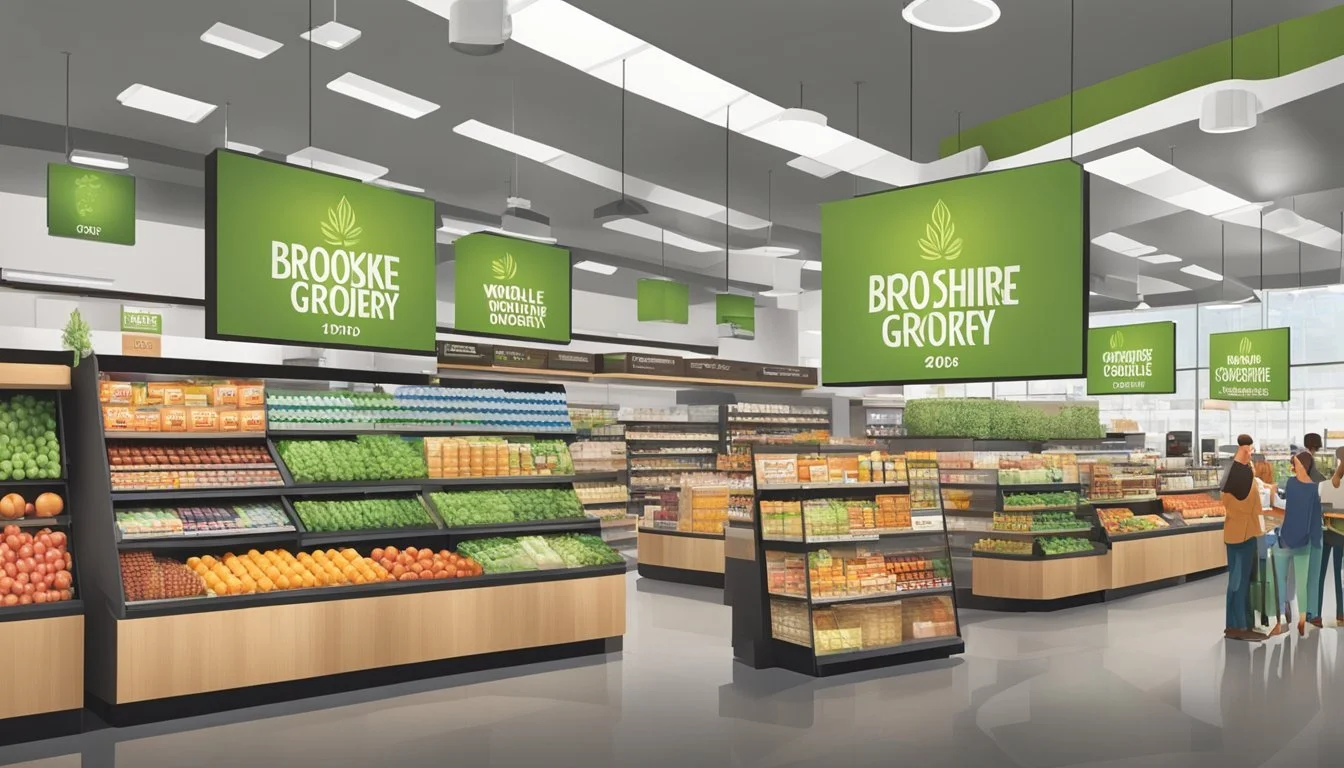Brookshire Grocery Company vs Whole Foods
A Comprehensive Comparison of Price, Quality, and Selection
Brookshire Grocery Company and Whole Foods represent two distinct approaches to grocery retail. Brookshire's, a regional family-owned chain, operates over 200 stores across Texas, Louisiana, Arkansas, and Oklahoma. Whole Foods, now owned by Amazon, has a nationwide presence and is known for its focus on natural and organic products.
When comparing Brookshire's and Whole Foods, customers will find notable differences in product selection, pricing, and overall shopping experience. Brookshire's offers a more traditional grocery store format with a mix of conventional and organic options, while Whole Foods specializes in natural and organic products with a premium price point.
Both chains have their strengths and appeal to different consumer preferences. Brookshire's has deep roots in local communities and provides a familiar shopping environment. Whole Foods, on the other hand, caters to health-conscious consumers seeking a wider range of organic and specialty items.
Company Overview
Brookshire Grocery Company and Whole Foods are two distinct players in the U.S. grocery retail landscape. Both have unique histories, business models, and service offerings that shape their market positions today.
History and Expansion
Brookshire Grocery Company started in 1928 when Wood T. Brookshire opened a small store in Tyler, Texas. The company grew steadily, expanding into Louisiana and Arkansas. Today, Brookshire operates over 200 stores under various banners including Brookshire's, Super 1 Foods, and Spring Market.
Whole Foods began in 1980 in Austin, Texas. It rapidly expanded through acquisitions and new store openings. The company became known for its focus on natural and organic products. In 2017, Amazon acquired Whole Foods, further enhancing its growth potential and digital capabilities.
Business Model and Services
Brookshire Grocery Company operates as a regional, family-owned business. It focuses on providing a mix of national brands and private label products. The company runs different store formats to cater to various customer segments.
Whole Foods positions itself as a premium, health-conscious retailer. It emphasizes organic, natural, and locally sourced products. The Amazon acquisition has integrated e-commerce and delivery services into Whole Foods' operations.
Both companies offer prepared foods, bakery items, and deli services. Brookshire maintains a strong community presence in its operating regions. Whole Foods leverages its national scale and Amazon's technology for enhanced customer experiences.
Products and Food Quality
Brookshire Grocery Company and Whole Foods Market offer distinct product ranges and quality standards. Both chains prioritize fresh, high-quality foods but differ in their focus and selection.
Variety and Selection
Brookshire Grocery Company provides a wide array of products, including national brands and their own private labels. Their Top Care line offers affordable over-the-counter remedies, while PAWS Premium caters to pet owners. The company stocks everything from sodas to soups and paper products to potato chips.
Whole Foods Market is known for its extensive selection of natural and organic products. They carry a diverse range of specialty items, international foods, and hard-to-find ingredients. Whole Foods also offers its own 365 Everyday Value brand, providing more budget-friendly options without compromising quality.
Organic and Natural Offerings
Whole Foods Market excels in organic and natural products. They have strict quality standards, banning over 100 ingredients commonly found in other stores. Their shelves are stocked with a vast array of organic produce, meats, dairy, and packaged goods.
Brookshire Grocery Company has increased its organic and natural offerings in recent years. While not as extensive as Whole Foods, they provide a selection of organic produce and natural grocery items to cater to health-conscious shoppers.
Freshness of Produce and Meat
Both chains prioritize fresh produce and high-quality meats. Whole Foods is known for its stringent standards, sourcing from local farms and emphasizing sustainable practices. They offer a wide variety of unique and seasonal fruits and vegetables.
Brookshire Grocery Company focuses on providing fresh, locally-sourced produce when possible. Their meat departments offer quality cuts and often feature local or regional suppliers. While perhaps not as extensive as Whole Foods, Brookshire's selection of fresh items is generally reliable and of good quality.
Pricing Strategy
Brookshire Grocery Company and Whole Foods employ distinct pricing strategies that reflect their target markets and brand positioning. These strategies encompass everyday pricing as well as promotional tactics.
Comparative Cost Analysis
Brookshire Grocery Company aims to offer competitive prices on everyday items. Their pricing structure tends to be more budget-friendly compared to Whole Foods. Brookshire focuses on providing value to cost-conscious shoppers in regional markets.
Whole Foods, known for its premium offerings, generally has higher prices. This reflects their emphasis on organic, natural, and specialty products. However, since Amazon's acquisition, Whole Foods has made efforts to lower prices on select items.
A typical grocery basket at Brookshire often costs less than at Whole Foods. For example, staples like milk, eggs, and bread are usually priced lower at Brookshire stores.
Sales and Promotions
Brookshire Grocery Company regularly offers weekly specials and digital coupons. Their loyalty program provides additional savings opportunities for frequent shoppers. Seasonal sales and holiday promotions are common tactics used to attract customers.
Whole Foods runs periodic sales on specific product categories. Their "Prime Member Deals" offer exclusive discounts to Amazon Prime subscribers. These deals can significantly reduce prices on select items, sometimes matching or beating competitors' prices.
Both chains use promotional pricing to drive traffic and compete in local markets. However, Brookshire tends to offer more frequent sales across a wider range of products compared to Whole Foods.
Customer Experience and Convenience
Brookshire Grocery Company and Whole Foods offer distinct customer experiences and convenience options. Both retailers prioritize service and aim to create pleasant shopping environments, but differ in their approaches to store layout, amenities, and digital offerings.
Store Layout and Shopping Environment
Brookshire stores typically feature a traditional supermarket layout with wide aisles and clearly marked departments. The atmosphere is bright and clean, with a focus on efficiency. Produce sections showcase fresh fruits and vegetables, while meat and seafood counters offer personalized service.
Whole Foods stores are known for their upscale, market-like ambiance. Wooden fixtures, mood lighting, and artful product displays create an inviting atmosphere. Departments are often arranged in a winding path to encourage exploration. Open food preparation areas allow customers to watch staff members craft fresh meals and baked goods.
Both chains prioritize cleanliness and organization. Signage helps customers navigate departments and find products easily.
Additional Services and Amenities
Brookshire offers:
In-store pharmacies at many locations
Floral departments
Money services (bill pay, money transfers)
Fuel centers at select stores
Whole Foods provides:
Extensive prepared foods sections
Wine and beer bars in some stores
Cooking demonstrations
Specialty cheese counters
Bulk foods departments
Both retailers feature bakeries with fresh-baked goods and custom cake ordering. Deli counters offer sliced meats and cheeses, as well as ready-to-eat meals.
Online Shopping and Delivery Options
Brookshire provides online ordering through its CURBSIDE service. Customers can pick up groceries at designated times or opt for home delivery in select areas. The company's mobile app allows for easy list-making and order placement.
Whole Foods leverages Amazon's technology for online ordering. Prime members enjoy free delivery on orders over a certain threshold. The Amazon app integrates Whole Foods shopping, making it convenient to browse products and place orders.
Both retailers offer digital coupons and personalized deals through their respective apps or websites. These features help customers save money and plan their shopping trips more efficiently.
Corporate Responsibility and Community Impact
Both Brookshire Grocery Company (BGC) and Whole Foods Market demonstrate strong commitments to social and environmental responsibility. They prioritize sustainability initiatives and actively engage in community support programs.
Sustainability Efforts
BGC focuses on environmental stewardship through its distribution centers and stores. The company implements energy-efficient technologies and waste reduction practices across its operations. Whole Foods Market takes a more comprehensive approach to sustainability. They have set ambitious goals to reduce food waste, lower carbon emissions, and promote responsible sourcing. Whole Foods publishes an annual Impact Report detailing their progress in areas like combating food waste and reducing their carbon footprint.
Community Involvement and Employment
BGC, a family-owned business since 1928, emphasizes local community support. They donate to organizations addressing hunger relief, education, health, and family wellbeing. BGC's "Focus on the Future" scholarship program helps employees and their children pursue higher education. Whole Foods Market engages in community giving and responsible sourcing practices. They support local producers and have programs to assist small-scale farmers and artisans. Both companies prioritize employee development and offer competitive benefits packages to attract and retain talent in the competitive grocery industry.
Brand Presence and Marketing
Brookshire Grocery Co and Whole Foods Market employ distinct strategies to establish their brand identities and connect with customers. Their approaches to advertising, brand recognition, and private label offerings showcase their unique market positions and target audiences.
Advertising and Brand Recognition
Brookshire Grocery Co focuses on local community engagement and regional advertising. They sponsor community events and use targeted local media to build brand loyalty. Their stores, including Super 1 Foods, are well-known in their operating areas of Texas, Louisiana, Arkansas, and Oklahoma.
Whole Foods Market, owned by Amazon, leverages a national presence with broader marketing campaigns. They emphasize their commitment to natural and organic products through various channels, including social media and partnerships with health-focused influencers. Whole Foods' distinctive green logo and store designs contribute to high brand recognition across the United States.
Private Label Brands
Brookshire Grocery Co offers several private label brands. These include Food Club for groceries, Goldenbrook for dairy products, and Simply Done for household items. Their private labels aim to provide quality products at competitive prices, appealing to budget-conscious shoppers.
Whole Foods Market's 365 Everyday Value brand is a cornerstone of their private label strategy. It spans organic and conventional products across various categories. Whole Foods also features specialty private labels like Engine 2 Plant-Strong for plant-based items. Their private brands emphasize natural ingredients and ethical sourcing, aligning with the company's overall brand image of health and sustainability.
Competitive Analysis
Brookshire Grocery Company and Whole Foods operate in distinct market segments within the competitive grocery retail landscape. Their positioning, strategies, and target demographics differ significantly, shaping their respective roles in the industry.
Market Position Among Competitors
Brookshire Grocery Company primarily serves regional markets in Texas, Louisiana, and Arkansas. It competes with other mid-sized regional chains and larger national players. The company's recent acquisition of Reasor's in Oklahoma expanded its footprint and market share.
Whole Foods, owned by Amazon, occupies a premium niche in the natural and organic foods sector. It faces competition from specialty retailers like Natural Grocers and Sprouts, as well as conventional grocers expanding their organic offerings.
Walmart and Kroger dominate the overall U.S. grocery market, pressuring both Brookshire and Whole Foods in different ways. Albertsons and regional players like Central Market also vie for market share in overlapping territories.
Comparison to Other Grocery Chains
Brookshire Grocery Company focuses on providing value and community engagement in smaller markets. Its pricing strategy aims to be competitive with larger chains while offering personalized service.
Whole Foods maintains higher price points, justifying them through product quality and sustainability practices. This positions it as a lifestyle brand more than a traditional grocer.
Both chains have adapted to increased competition. Brookshire has invested in e-commerce and expanded its private label offerings. Whole Foods leverages Amazon's logistics network for delivery services.
In terms of store experience, Whole Foods emphasizes its prepared foods section and in-store dining options. Brookshire stores tend to be more conventional in layout but focus on local product selections.
Innovation and Future Prospects
Brookshire Grocery Company and Whole Foods are embracing technology and expansion to stay competitive in the evolving grocery landscape. Both chains are investing in digital solutions and growth strategies to meet changing consumer needs.
Technology Integration and E-commerce
Brookshire Grocery Company has implemented online ordering and curbside pickup services across many of its stores. The company has also upgraded its point-of-sale systems and inventory management software to improve operational efficiency.
Whole Foods, backed by Amazon's technological prowess, has made significant strides in digital innovation. The chain has rolled out AI-powered smart carts in select locations, enhancing the in-store shopping experience. Whole Foods has also expanded its e-commerce capabilities, offering same-day delivery through Amazon Prime in many markets.
Both retailers have mobile apps that provide digital coupons, personalized offers, and loyalty program features to customers.
Growth Strategies and Expansion Plans
Brookshire Grocery Company has focused on strategic acquisitions to fuel its growth. The company recently finalized its purchase of Reasor's, an Oklahoma-based chain, adding over 200 stores across four states to its portfolio. This move positions Brookshire for future expansion in the region.
Whole Foods, under Amazon's ownership, has pursued a different growth strategy. The chain has been opening new stores in urban areas and experimenting with smaller-format locations. Whole Foods has also expanded its product selection to include more mainstream and affordable options, aiming to attract a broader customer base.
Both retailers are investing in store remodels and upgrades to create more appealing shopping environments and accommodate new technologies.
Conclusion
Brookshire Grocery Company and Whole Foods offer distinct shopping experiences for grocery buyers. Brookshire's focuses on serving local communities in Texas, Arkansas, and Louisiana with a mix of traditional and specialty store formats.
Whole Foods targets health-conscious consumers nationwide with its emphasis on natural and organic products. Both chains prioritize quality, but Whole Foods generally commands higher prices.
Brookshire's provides a more familiar, small-town feel in many locations. Whole Foods stores often have a sleeker, upscale ambiance with extensive prepared food options.
For everyday staples and regional favorites, Brookshire's offers competitive prices and selection. Health-focused shoppers may prefer Whole Foods' wider array of organic and specialty diet items.
The better choice depends on individual preferences, budgets, and dietary needs. Brookshire's suits those seeking a traditional grocery experience with local touches. Whole Foods appeals to consumers prioritizing natural products and willing to pay a premium.
Both chains have loyal customer bases and continue evolving to meet changing shopper demands. Ultimately, the "best" option comes down to personal priorities in grocery shopping.







